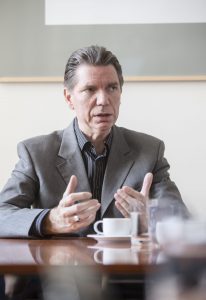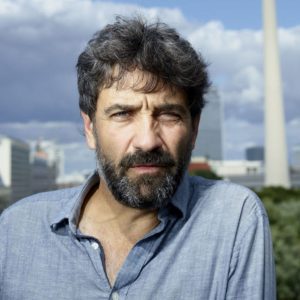Lars Christian Koch
The partial reconstruction of the Berlin Palace (three baroque facades and the Schlüterhof) approved by the German Bundestag in 2002 was reviewed in 2008, and it was decided to also rebuild the cupola. Overall, the structural reconstructions were to feature accurate copies of the historical details, which also included numerous monarchic and Christian iconographic elements, such as the cupola and the cross.
On the one hand, this documents the, in many respects unusual and problematic, history of Prussia and Germany in its entirety, and on the other, this results in an obligation to never cease to address it. We cannot allow the renewed conclusion of power structures from the symbols in various cultural and political scenarios at a place of culture and science, of exchange and diversity.
Within this scope, the reconstruction of the palace with all of its symbolism will be an ongoing contentious issue and as such, it will be generative.
The Humboldt Forum’s policy with regard to its contents as well as its programme structures will therefore have to focus on offering a high degree of diversity and multiple perspectives. This can be achieved by making a clear statement on global, cooperative, exhibitions and programmes with shared interpretive authority as well as through artistic interventions and presentations. Within this scope, the reconstruction of the palace with all of its symbolism – which particularly obviously includes the cupola and the cross – will be an ongoing contentious issue and as such, it will be generative.
Due to its proximity to the museum buildings on Museumsinsel, the Berlin Palace was also closely connected to the ethnological and Asian art collections, especially in the 19th century. Since then, this has also included Germany’s colonial history. Against this background, particularly the exhibitions of these two collection areas call for a critical interpretation of the presentation on the inside in the context of the symbolism on the outside of the building. This can only happen in collaboration with the cultures of origin and their national institutions. It also depends on extensive provenance research that is not only limited to the circumstances surrounding the acquisition of each object but also takes its present significance and cultural interrelations as well as transformations into account, which in turn must be in line with the presentation in a reconstructed palace with all of its symbols of power and religion rooted in history.
Gorch Pieken
From 2013 to 2020, a building with the same dimensions and look of the Berlin Palace was built commemoratively on its authentic site in Berlin’s city centre, where the glory and the ruin of Germany’s history can be experienced in equal measures. In the course of its history, the palace architecture has already frequently been the object of symbolic rededication, and the reconstruction of the baroque palace facade can also be interpreted as yet more toying with authenticities.
The palace was a central aristocratic seat designed for feudal self-representation; it was an important fine arts venue and served as a stage for the premieres of famous works of music; in 1806, the freely elected city government which Carl Friedrich Zelter belonged to was given its authority here by Napoleon, and in 1919, Karl Liebknecht proclaimed the “free socialist republic of Germany” from the palace balcony. And later on, the ruins that were left after the Second World War were torn down to make room for the GDR’s Palast der Republik.
Which historical period would the new residents of the palace like to identify themselves with? Which of the palace’s pasts do they consider a typical example? For the Humboldt-Universität, this question is easy to answer: their own.
The palace became a science hub in the 1920s. The university’s internationally renowned department of psychology shared the palace with the “Japan Institute”, the “Mexico Library”, the inner mission institute for social ethics and science established by Reinhold Seeberg, the school of journalism, which was part of the faculty for Protestant theology, or the natural science history research institute that was founded in 1927, for example.
However, the links between the palace and the university go back further. When the university was founded, it received major parts of the Hohenzollern’s private library, and the research and teaching previously carried out by the renowned court apothecary were fully transferred to the university.
When the Humboldt-Universität occupies its exhibition spaces in the Humboldt Forum in late 2020, it will also be doing so as a successor of the Berlin Palace cabinet of art and curiosities, in two respects: numerous university collections originated in this cabinet, and the Humboldt-Universität’s exhibition at the Humboldt Forum has been modelled on its form of communication. The cabinet of art and curiosities was not limited to a mere summary of the facts and the communication of knowledge. It was a room for sensual realisation, where access to science was facilitated in different ways through playful and aesthetic elements.
Just imagine how surprised the visitors will be when something that looks like candy suddenly tastes salty!
With this, the Humboldt-Universität is also referencing its name-givers, Wilhelm and Alexander von Humboldt. One was an educational reformer, and the other a pioneer of popular science. Both were regular visitors to the palace, yet both nevertheless contributed to the shaking of the foundations of the Kingdom of Prussia’s supposedly God-given social hierarchy. As liberals, they believed in the key values of the Enlightenment, which define the self-image of modern democracies and are essential for the quality of science. The freedom of science also depends on the freedom of the individual. And, vice versa, Alexander von Humboldt supplied the impulse for a cosmopolitan policy that “makes the circulation of knowledge the foundation of democratising societies” (Ottmar Ette).
In late 2020, the Humboldt-Universität will be opening a science exhibition in the rebuilt Berlin Palace that also intends to make a contribution to democratic identity development as a venue for political education and awareness raising.
All buildings with a cultural function have a characteristic shell that is like a packaging underneath which the contents can be guessed. Just imagine how surprised the visitors will be when something that looks like candy suddenly tastes salty!
Paul Spies
Of course, we as the Humboldt Forum stakeholders must state our position with regard to this building – the justifiably contentiously discussed reconstruction of a palace whose architectural design documents the Hohenzollern monarchy’s claim to rule.
However, I believe that the Humboldt Forum can become a cosmopolitan venue for debate, even with a cupola and a cross on its roof. Let’s do something unusual with the cross! How about if it was not there permanently, and we made the cupola temporarily available to another religion?
Equally problematic is the recreated scroll that runs around the tambour of the cupola with its inscription in golden letters on a blue background. The text – a quotation from the Bible assembled from two different New Testament verses – is based on the original scripted by King Frederick William IV himself. When it says “that at the name of Jesus every knee should bow, of things in heaven, and things in earth, and things under the earth”, this should be interpreted as the reaction of those who were in power in Prussia to the revolutionary events in Berlin in 1848. As ruler by divine right, Frederick William IV demanded that his subjects should bow to him! Such a message, communicated in gilded letters, must not go uncommented at the Humboldt-Forum: the German revolutions of 1848, Berlin’s first powerful democracy movement, will therefore be a key theme in the Berlin exhibition.
I believe that the Humboldt Forum can become a cosmopolitan venue for debate, even with a cupola and a cross on its roof.
In the exhibition spaces dedicated to the Berlin exhibition, we will also focus on Berlin as a place that affords liberal scope and a place where religion cannot be pursued in peace. A video on the subject of “Faith”, for example, features three women from Berlin of Christian, Muslim and Jewish origins discussing democracy and tolerance in the context of religious freedom in Berlin. Jointly, they came up with an alternative idea for the top of the Humboldt Forum’s cupola: it could be crowned by a menorah, a crescent and a cross, all united in one sculpture! The model for this will be on display in our exhibition.
Through precisely such approaches, we will be able to fulfil the building’s claim of its intention to function as a forum with its contents, and to carry the discussion far beyond our exhibition.

